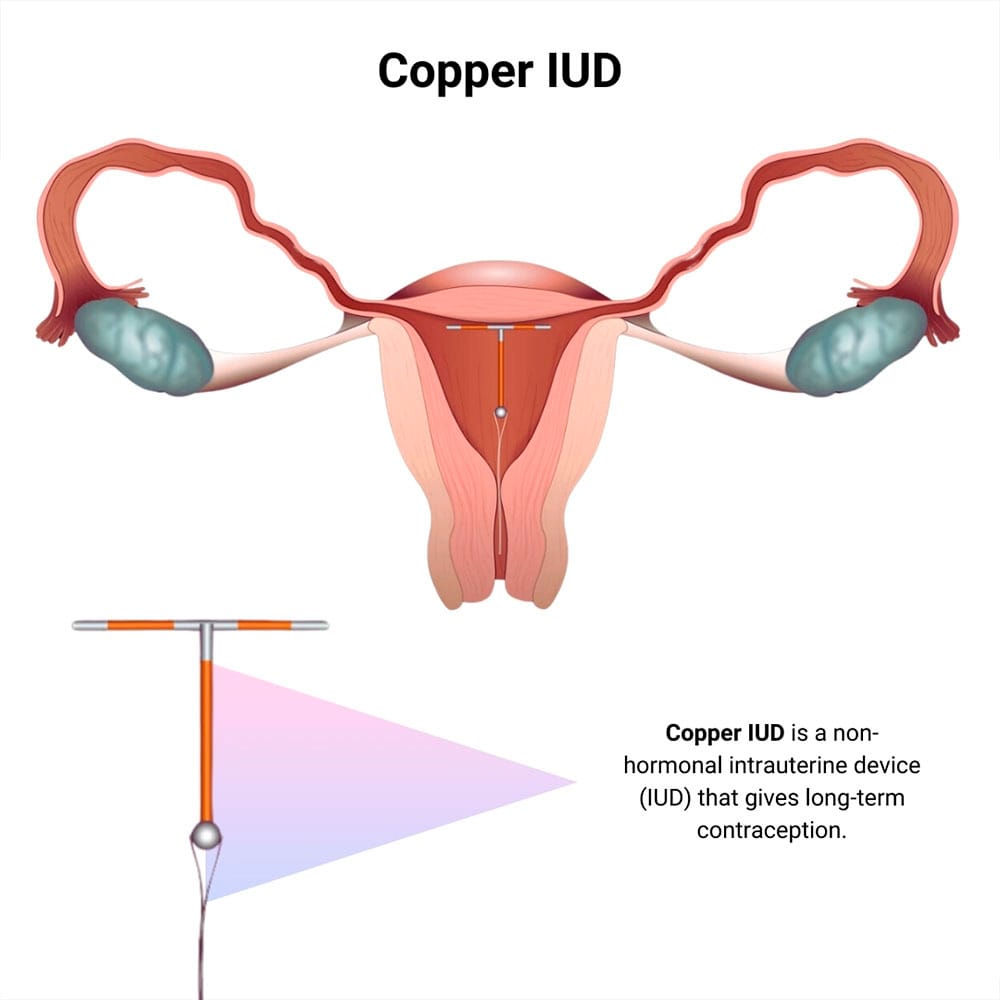What Is a Copper IUD?
 Copper IUD is a non-hormonal intrauterine device (IUD) that gives long-term contraception. It’s a small, T-shaped device with plastic copper wire coiled around its arms. It also provides emergency contraception if used within five days of unprotected sex, and it’s one of the most effective birth control methods you can use. Additionally, it’s an ideal option for those who want to avoid the side effects of a hormonal IUD.
Copper IUD is a non-hormonal intrauterine device (IUD) that gives long-term contraception. It’s a small, T-shaped device with plastic copper wire coiled around its arms. It also provides emergency contraception if used within five days of unprotected sex, and it’s one of the most effective birth control methods you can use. Additionally, it’s an ideal option for those who want to avoid the side effects of a hormonal IUD.
Copper IUD, of which ParaGard® is a reputable, safe and effective brand, requires no maintenance once inserted and prevents pregnancy for up to 10 years. If you think you need a long-term solution to prevent pregnancy, a copper IUD might be the best solution for you. But you need to talk to an experienced reproductive doctor about all your options.
Dr. Felix Cohen, founder and director of Cohen Medical Practice (CMP), is a board certified gynecologist and expert in women’s reproductive health. From puberty to pregnancy testing and planning and menopause, he guides you through every step.
Other birth control methods you can get at CMP include:
What’s the Procedure for Inserting a Copper IUD?
Even though it’s a simple procedure, only a medical expert can insert a copper IUD. Before the insertion procedure, your doctor conducts a pelvic exam to look at the size of the uterus to ensure the viability of the IUD and to understand the depth of your uterus.
The next steps of IUD insertion include:
- Inserting a speculum to open your vagina, similar to when you receive a Pap smear exam, to look at the cervix and prepare for the IUD insertion
- Cleaning your cervix with an antiseptic solution to prevent infection
- Measuring the depth of your uterus with a uterine sound machine to ensure the correct fitting of the IUD
- Inserting the copper IUD that’s folded inside a small thin tube through the cervix and into your uterus
- Opening the IUD to its T-shaped form once it’s in your uterus
- Cutting the strings if they’re too long
The insertion process takes about five to 10 minutes and after that, a little spotting and pain are possible, but it stops quickly. Your CMP doctor may recommend avoiding sex for one or two days if there’s any residual pain or discomfort. There’s no backup contraception needed after insertion. After four to six weeks, your doctor schedules a follow-up.
When Can I Get a Copper IUD?
A copper IUD may be inserted at any time in your cycle, as long as you’re not pregnant. You may use it right after childbirth, and it doesn’t affect breastfeeding. You may use it after an abortion as well, but your doctor makes sure no infection is present.
Sometimes, it’s unsafe to use copper IUDs, such as if:
- You have abnormalities in the uterus
- You have pelvic inflammatory disease
- You’re allergic to copper
- You have Wilson’s disease
Copper IUDs like ParaGard are made of a plastic frame that’s wrapped in a thin layer of copper wire. Copper is toxic to sperm and creates a toxic environment in the uterus and fallopian tubes that makes it difficult for the sperm to stay alive. It stops the sperm from moving through the reproductive path, which prevents fertilization.
Even if fertilization has occurred, which is very rare, the ParaGard device then prevents the fertilized egg from implanting in your uterus. This occurs because the IUD has created an inflammation response, which leads to an inhospitable environment for an embryo to implant.
Is a Copper IUD Safe?
Copper IUDs like ParaGard are usually safe for everyone, which is why the doctors at CMP choose this brand. But like other medical devices, they come with potential risks and side effects, which also are greatly mitigated when you rely on CMP experts in reproductive health to perform the insertion and monitor it over the years.
Risks may include:
- Spotting between period cycles
- Cramping during periods
- IUD coming out of the uterus
Copper IUDs provide 99 percent effectiveness and are designed for long-term use. If you want to remove it before its time is up, it can be done, as it doesn’t affect fertility.
What Should I Say to My Partner after My IUD Insertion?
Discuss with your partner how IUDs work and how they might affect sex after insertion. If you experience pain during intercourse, communicate it with your partner. Inform them about IUD strings, which extend a little, so they’re not surprised. An IUD shouldn’t affect your sensations during sex, but talking about the process helps alleviate any fears.
If you want a birth control method that doesn’t require reminders and breaks from your partner, then the ParaGard IUD may be an ideal choice for you. Not only is it effective, but it prevents you from the hormonal IUD stress as well. Even with all the advantages, don’t decide without your doctor’s guidance and advice. Contact Dr. Felix Cohen at Cohen Medical Practice (CMP) right away for an appointment and a routine pelvic exam.

